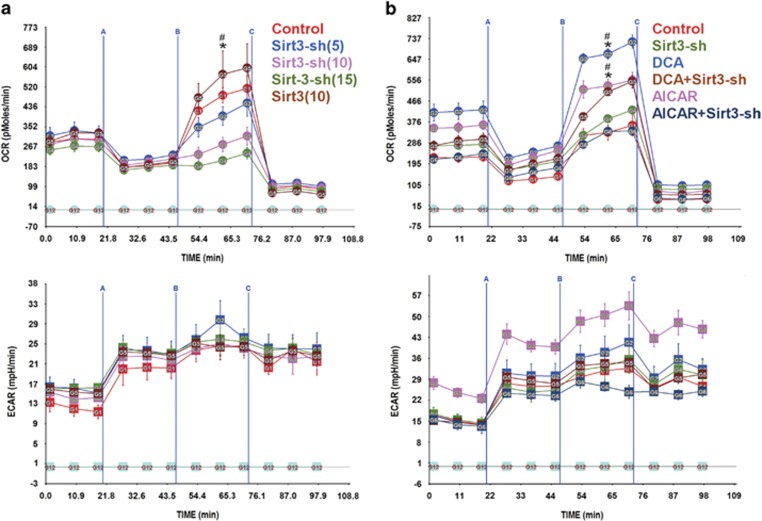Figure 7.
Sirt3 is required for development of RRC. (a) Neonatal rat cardiac myocytes cultured in complete growth medium were infected with adenoviral vectors harboring a scrambled control sequence, shRNA targeting Sirt3 (Sirt3-sh) (5, 10 or 15 moi) or a Sirt3 overexpressor (10 moi), for 24 h. The medium was then replaced with serum-free XF medium containing 17.5 mM glucose plus 100 μM palmitate-BSA, for 1 h. The mitochondrial stress test was then performed as described in Materials and Methods, n=3–4. Error bars represent S.E.M., *P<0.05 max OCR versus basal OCR for control, at the time point indicated; #P<0.05 max OCR for control versus max OCR for Sirt3-sh treated (10 and 15 moi), at the time point indicated. (b and c) Neonatal rat cardiac myocytes cultured in complete growth medium were treated with 500 μM AICAR (b) or 1 mM DCA (c) in the presence of an adenoviral vector harboring a scrambled control sequence or a shRNA targeting Sirt3 (Sirt3-sh) (10 moi), for 24 h. The medium was then replaced with serum-free XF medium containing 17.5 mM glucose plus 100 μM palmitate-BSA, 17.5 mM glucose plus 100 μM palmitate-BSA plus 1 mM DCA or 17.5 mM glucose plus 100 μM palmitate-BSA plus 500 μM AICAR, for 1 h. The mitochondrial stress test was then performed as described in Materials and Methods, n=3–4. Error bars represent S.E.M., *P<0.05 max OCR versus basal OCR for DCA- or AICAR-treated cells, at the time point indicated; #P<0.05 max OCR for DCA or AICAR treated versus max OCR for DCA+Sirt3-sh or AICAR+Sirt3-sh treated, at the time point indicated

